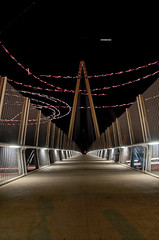teach me how to fish
Mere moments ago, I was meeting with some of the administration at the business school where I am pursuing my MBA, and found myself stunned by a statement. For the most part, I am very happy with my education here. Most of the faculty I’ve had have been very solid to great most of the time, with only a few duds. However, I was shocked when I was given the “you’re grad students, you should be able to take care of/figure out X yourself” speech when meeting with one of the academic administrative leaders. I was seeking advice on how to handle something, and was essentially told to handle part of it myself (not all – I’m trying to be accurate in my depiction so that I am not unfair to the person with whom I was meeting)
Don’t get me wrong – I am 100% behind the “teach someone to fish” model of learning. I want to learn how to do something – management, finance, whatever – so that I can go out and do it myself. It can be theoretical, but even then I should be able to come away from that with an ability to apply those theories in a meaningful way. I would never advocate for someone just handing me or any student a finished or nearly-finished idea. I want to be stimulated, intellectually, and I want my opinions and positions to be questioned, challenged, and refined.
However, there are people that should be helping me along the way – teaching me how to fish. Those people are the faculty and, in a broader but perhaps even more important sense, the heads of the various academic departments that help define the direction and goals of that set of faculty. It is their job to challenge me, to make me, as an adult with presumably some degree of intelligence (a sound presumption since I got into the program), support my positions, etc.
Faculty should also care about whether their students are learning. They should provide counsel and guidance. Not hand-holding. Not provision of answers. But providing guidance is part of their job. It doesn’t matter how old I am or that I’m a grad student rather than an undergrad (and I think undergrads should be taught to fish, too, for what it’s worth) – it is a terrible, terrible thing to feel that there are faculty and/or academic administrators out there that feel that there are questions we shouldn’t ask because we should already know the answers. To have our concerns – even the poorly formed ones – be dismissed as part of “something we should already know.”
After all, when do we know when we are asking one of those questions? How shall we know if we’re pushing back in the right way, to our benefit, if it is suggested that, as an adult, there are some things that we should not question or should just figure out ourselves?
October 21, 2009 Biz School, Musings, Rants, and Random Thoughts 0 Read more >


